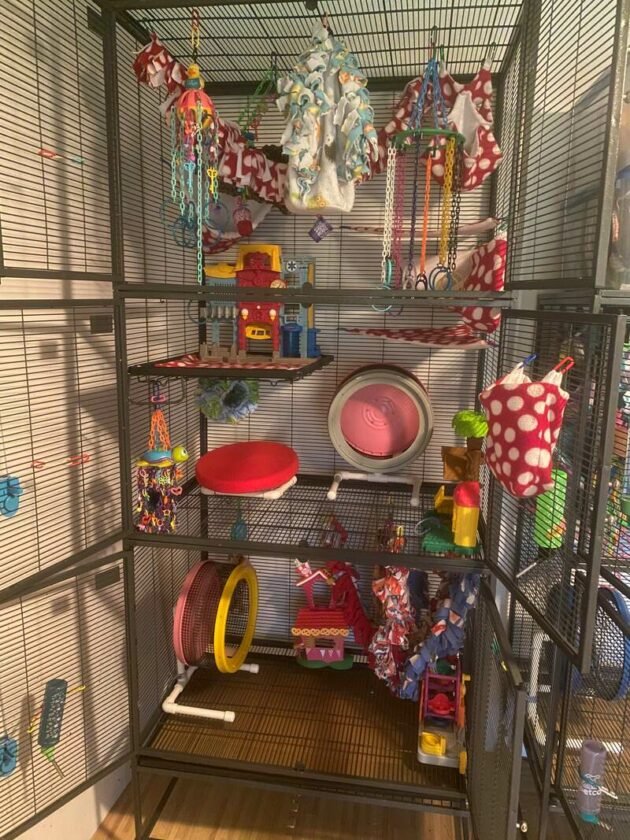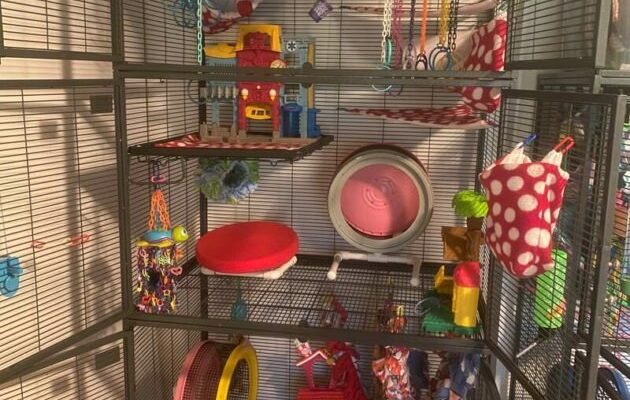
Sugar gliders are social and active animals that thrive in environments where they can explore and play. Just as you wouldn’t want to live in a cramped space, your sugar glider deserves a well-sized cage that meets their needs. It’s not just about the size; the layout, toys, and placement make all the difference. Think of it like arranging your living room: you want to ensure everything flows well and feels inviting.
Choosing the Right Cage Size
When it comes to sugar gliders, the size of the cage can’t be overstated. These little critters have tons of energy and need space to move around. Ideally, you should aim for a cage that’s at least 24 inches wide, 24 inches deep, and 36 inches high. The taller the cage, the better since sugar gliders love to climb!
Why height? Well, sugar gliders are natural climbers. They enjoy jumping, gliding, and exploring vertical spaces. A multi-level cage is perfect for them. Think of it as a high-rise apartment with lots of floors to play on. You might be wondering—can I just use a smaller cage? While a small cage might seem adequate for short-term use, it can lead to boredom and stress for your pet, ultimately affecting their health and happiness.
Keep in mind that the bars of the cage should be spaced no more than 1⁄2 inch apart. This is crucial to prevent your sugar glider from escaping or getting stuck. Look for a cage with a removable bottom tray to make cleaning a breeze. After all, you want to maintain a tidy living space for your furry friend!
Adding Toys and Enrichment
Now that you have the cage size sorted, let’s talk about what to put inside. Just like us, sugar gliders need stimulation to stay happy and healthy. A variety of toys will not only keep them entertained but also encourage their natural behaviors.
Here are some great toys to consider:
- Ropes and Bridges: Sugar gliders love to climb and swing, so adding ropes or bridges made of safe materials can keep them entertained for hours.
- Hammocks: Soft hammocks give your sugar glider a cozy spot to nap and feel secure. They love snuggling up while they sleep!
- Foraging Toys: These toys encourage your glider to work for their treats, mimicking their natural instincts to search for food in the wild.
- Plastic Toys: Lightweight plastic toys or balls that they can push and toss around can provide good exercise and mental stimulation.
You might be wondering how often you should rotate the toys. It’s a good idea to switch them out every couple of weeks to keep things fresh and exciting. Just like a kid who gets bored of the same toy, your sugar glider will appreciate new challenges!
Optimal Cage Placement
Once you have the right cage and toys, it’s time to think about where to place it. The placement of your sugar glider’s cage can significantly impact its well-being. Ideally, you want to keep the cage in a quiet area where they can safely observe the household activity.
Avoid placing the cage in direct sunlight or drafty areas. While sugar gliders love warmth, they can easily overheat. A spot that maintains a stable temperature will be best. Consider placing the cage in your living room or a family area where they can feel like part of the family. Social creatures by nature, sugar gliders thrive when they have interaction with their humans.
Also, think about the height of the cage. Elevating it off the ground can help your glider feel more secure, but make sure it’s at a level that allows you to easily interact with them. You don’t want to constantly bend down to feed or play with them!
Creating a Safe Environment
While sugar gliders are cute little animals, it’s essential to create a safe environment for them in their cage. Start by removing any harmful objects that could potentially hurt them. Avoid toys with small parts that might be swallowed, and steer clear of any household items that could pose a risk.
Make sure the cage is secured tightly to prevent any escape attempts. Sugar gliders can squeeze through surprisingly small spaces! Regularly check the bars for any signs of wear or damage. Keeping them safe also means ensuring they have proper ventilation in the cage. Good airflow helps maintain a comfortable environment.
You might find it helpful to line the bottom of the cage with a non-toxic bedding material. This can absorb moisture and reduce odors. Also, consider adding some branches or safe natural wood. Not only does it provide enrichment, but it also allows your sugar glider to exercise those little limbs.
Feeding and Nutrition Inside the Cage
Setting up a cage isn’t just about the structure; you also have to think about your sugar glider’s dietary needs. You’ll want to keep their food and water bowls inside the cage at all times. Sugar gliders thrive on a balanced diet that includes fruits, vegetables, and specially formulated pellets.
It’s crucial to keep their food fresh and clean. You’ll want to check the dishes daily and rinse them out to avoid any build-up that can lead to bacteria. Some owners prefer using a foraging tray to encourage natural foraging behavior, making mealtime fun!
Make sure you’re aware of toxic foods. Certain fruits like grapes and avocados can be harmful. Always do your research before introducing new foods to their diet, and be sure to consult with a vet who specializes in exotic pets if you have questions.
Final Touches and Personalization
Once you have everything set up, take a moment to step back and look at your creation! Personalizing your sugar glider’s cage can add a creative touch. Think about adding some decorations or items that reflect your style while ensuring they’re safe for your pet.
Consider using non-toxic plants or colorful fabric to make the space feel inviting. Just remember, everything should be safe for your little friend to chew or climb on. Sugar gliders are naturally curious, so a little decor can inspire exploration.
As you personalize the cage, take note of what seems to engage your sugar glider the most. Observe their habits and tweak the setup as needed—after all, their environment should evolve as they grow and change.
In conclusion, setting up the perfect cage for your sugar glider is about creating a vibrant, safe, and stimulating environment. Focus on size, features, placement, and safety to make your sugar glider feel at home. With a little love and care, you’ll provide a space where they can thrive and be happy!

